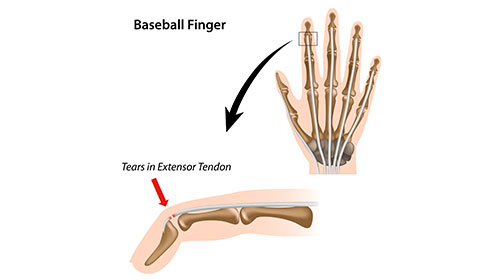
General Information
Every year, when the baseball season gets underway, doctors start seeing cases of “baseball finger.” This condition, which is also called “mallet finger,” is often caused when a ball hits the tip of your finger, bending it down.

Fingers can bend down (toward the palm of your hand) only about 35 to 40 degrees. The force of a batted ball can push the finger beyond that limit and tear the tendon that controls muscle movement in the finger. The force may even be great enough to pull tiny pieces of bone away as well. When the tendon is detached, the tip of the finger cannot be straightened out and it hangs down abnormally.
This is initially a very painful injury, and the top of the finger near the fingernail will be tender, slightly swollen and red. If it happens to you, stop playing. Immediately apply ice, and elevate your hand above the level of your heart. Contact a doctor who may request an X-ray to see if there is any damage to the bone. Sometimes, if the finger joints are jammed against each other, cartilage damage results. The joint may also be dislocated.
The finger will have to be immobilized in a splint for several weeks. This ensures that the tendon is correctly positioned for proper healing. There may be an additional problem if there is also an open wound along with the tendon tear. The open wound creates a risk of infection in the hand. In these cases, surgery may be necessary.
Baseball finger can also be a problem for children because it may involve injury to the cartilage that controls bone growth. This type of injury requires careful evaluation and treatment so that the finger does not become stunted or deformed.
